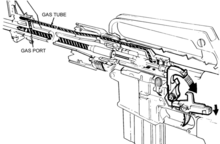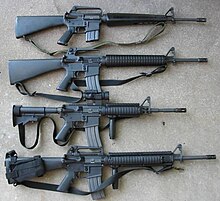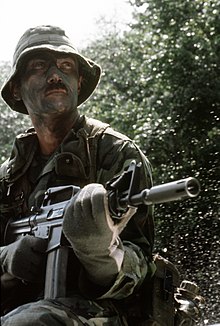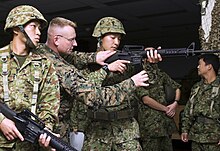M16 (rifle)
| M16 | |
|---|---|

|
|
| general information | |
| Civil name: | AR-15 |
| Military designation: | M16 (M16A1, M16A2, M16A3, M16A4) |
| Country of operation: | United States and 80+ other countries, see usage |
| Developer / Manufacturer: | Eugene Stoner, ArmaLite Inc., Colt Defense LLC / Colt Defense LLC Fabrique Nationale (FN) |
| Manufacturer country: | United States |
| Production time: | since 1960 |
| Model variants: | see model overview |
| Weapon Category: | Assault rifle |
| Furnishing | |
| Overall length: | depending on the model ~ 980 mm |
| Weight: (unloaded) | depending on the model ~ 3.8 kg |
| Barrel length : | 508 mm |
| Technical specifications | |
| Caliber : | 5.56 × 45 mm NATO |
| Possible magazine fillings : | 30 cartridges (standard), optionally 2/5/10/20/30/40/90/100 cartridges |
| Ammunition supply : |
Bar magazine (up to 20 rounds), cam magazine , drum magazine |
| Cadence : | 700–950 rounds / min, depending on the model |
| Fire types: | see model overview |
| Number of trains : | 6th |
| Twist : | right |
| Visor : | Rear sight |
| Closure : | Turret lock |
| Charging principle: | Gas pressure charger |
| Lists on the subject | |
The M16 rifle, designated by the US Department of Defense (DOD) RIFLE 5.56-MM, M16 , was introduced in 1967 as an orderly weapon of the US armed forces. In the meantime it has largely been replaced by the Colt M4 , a shorter, improved variant of the AR-15 system.
development

With the model AR-15 developed by Eugene Stoner and the company ArmaLite , the requirements of the US armed forces for a new type of individual armament of soldiers were taken into account. As a consequence of the Second World War, the Korean War and a corresponding research program (SALVO), it was concluded that a high cadence (rate of fire) and large ammunition stocks were more important for soldiers than precision and range. The infantry armament of the future should be a format somewhere between a rifle and a submachine gun , without significantly sacrificing its effectiveness. Similar considerations on the German side had already led to the development of a medium cartridge and the 44 assault rifle during World War II .
As the US government in 1957, the company commissioned ArmaLite with the development of a number of test models, attacked this developed on 1955 by Eugene Stoner AR-10 caliber 7.62 x 51 mm NATO back. As a result, the AR-15 model in .223 Remington caliber was delivered to the United States Army for testing purposes in 1958 . The lock housing is made of a light metal alloy, while the straight shaft is made of plastic. In the absence of a hoped-for major order, ArmaLite had to sell the rights to Colt . This made further test series and improvements. In the summer of 1961, after successful troop trials, the first contingent of 8,500 assault rifles was purchased by the US Air Force , which put it into service as the M16. At the end of 1964 another of around 85,000 AR-15s for the US Army and another 19,000 for the US Air Force followed. By 1966, there were around 350,000 weapons in the American armed forces. In the US Army, the weapon was given the preliminary designation XM16E1 and differed from the USAF version M16 by the bolt forward assist on the right side of the housing and the row of teeth required for this on the bolt carrier. The closing aid was a requirement of the Army; this demanded to create a way to forcibly close the closure if it did not do this automatically under pressure of the closing spring.
Despite the initially successful tests, the new weapon concept did not pass the first practical test. Since there were problems with supplies and with the required specifications for the 5.56 × 45 mm ammunition, the composition of the propellant powder was changed without carefully testing the resulting deviations. The new powder led to a higher rate of fire and thus to a higher material load. In addition, the weapon became more dirty. In contrast to the M14 , the cartridge chamber and the inner wall of the barrel of the M16 were initially not hard-chrome-plated , which made the weapon more susceptible to corrosion. Cleaning accessories were not available at first, so soldiers were told the M16 was a self-cleaning weapon. Dirt and smoke traces in the weapon mechanism, however, often led to partially irreparable jamming , which in combat situations had serious disadvantages. To make matters worse, dismantling the weapon is more complex than with comparable weapons. There have been multiple reports of soldiers killed after having to disassemble their M16 for cleaning in the field for jamming due to pollution, which eventually led to an investigation by Congress into the incident.
Another disadvantage was the high ammunition consumption, as the M16 had less recoil than the M14. This made the weapon more controllable in continuous fire, while the M14 with fully automatic trigger is hardly controllable in this mode because of its powerful ammunition. Therefore, many soldiers viewed the M16 as a “personal machine gun” and fired excessively. This problem has been resolved by replacing the continuous fire function with a burst mode for firing three shots at a time from version A2 .
Despite the many improvements and improvements, the M16 has never completely lost its bad reputation. The cleaning problems were largely eliminated by the end of 1967 through suitable cleaning equipment, intensive training and changes to the weapon (hard chrome-plated barrel inside and cartridge chamber from M16A1) and the ammunition, but complaints about the weak ammunition were heard throughout the entire Vietnam War.
The fundamental problem with the AR-15 system is the heavy contamination of the locking system when the weapon is in operation. Instead of a gas piston with a drive rod, the gas pressure charging system has a thin gas tube that brings the hot powder gases containing soot and particles directly to the closure via the gas extraction nozzle. This construction, which Stoner took over from the Automatgevär m / 42 , enables weight and recoil reduction as well as almost free swinging of the barrel. However, particles of the powder gases are deposited everywhere in the locking system and can lead to problems after just a few hundred shots. This coating is difficult to remove, even with mechanical means. For this reason, there are a large number of different cleaning sets and gas piston conversion kits for AR-15 weapons alone. The HK416 , Barrett REC7 , LWRC M6, Remington R5 RGP, Ruger SR-556, and SIG Sauer SIG516 are examples of AR-15 platform-based, short-stroke assault rifles.
This gas system, which acts directly on the breech ( direct impingement ), heats the breech, bolt carrier and other parts when it fires. On the AR-10 , the cocking slide could get so hot that you could no longer touch it. This is one of the reasons why it was placed behind the upper part of the housing on the AR-15. The use of a silencer increases the gas pressure and thus the contamination, heating and wear, which sooner or later lead to damage to the weapon. This is one of the reasons why there are various adjustable gas blocks available as conversion kits. These reduce the amount of gas withdrawn or drain the excess.
Although the closing spring is located in the piston of the M16 , versions with a folding shoulder rest are possible. However, when the weapon is folded down, it can only fire the one cartridge that is in the chamber. The M231 FPW is a shortened version of the M16. The piston was removed, but the tube in which the closing spring is located (English: buffer tube ) protrudes far out of the weapon.
Despite the reports of technical errors, especially bolt blockages, load jams and susceptibility to dirt, the AR-15 was officially introduced into the armed forces of the United States from the end of 1967 with the model designation M16A1. From 1986 the improved model M16A2 replaced the older version A1. In 1994 the versions A3 (fully automatic) and A4 (three-shot) replaced the version A2.
Model overview
| Colt model | Military designation | in use at | Years of production | Barrel length | Trigger system |
|---|---|---|---|---|---|
| 601 | AR-15 | USAF | 1959-1963 | 508 mm | Safe-semi-auto |
| 602 | AR-15 XM16 |
USAF | 1963-1964 | 508 mm | Safe-semi-auto |
| 603 | XM16E1 | US Army, US Marines | 1964-1967 | 508 mm | Safe-semi-auto |
| 603 | M16A1 | US Army, US Marines | 1967-1982 | 508 mm | Safe-semi-auto |
| 604 | M16 | USAF | 1964-1965, 1970 | 508 mm | Safe-semi-auto |
| 604 modified | Mk 4 Mod 0 | US Navy | 1970/71 | 508 mm | Safe-semi-auto |
| 609 | XM177E1 | US Army | 1967-1968 | 250 mm | Safe-semi-auto |
| 610 | XM177 | US Army | 1966 | 508 mm | Safe-semi-auto |
| 610 | GAU-5 / P | USAF | 1966 | 508 mm | Safe-semi-auto |
| 629 | XM177E2 | US Army | 1967-1970 | 290 mm | Safe-semi-auto |
| 629 | GAU-5 / A / B | USAF | 1967-1970 | 250 mm | Safe-semi-auto |
| 630 | GAU-5 / A / A | USAF | ? | 250 mm | Safe-semi-auto |
| 645 | M16A1E1 / PIP | ? | ? | 508 mm | Safe-Semi-Auto or Safe-Semi-Burst |
| 645 | M16A2 | US Army, US Marines | 1984-1996 | 508 mm | Safe semi-burst |
| 645E | M16A2E1 | ? | ? | 508 mm | Safe semi-burst |
| - | M16A2E2 | ? | ? | 508 mm | Safe semi-burst |
| 649 | GAU-5 / A | USAF | ? | 290 mm | Safe-semi-auto |
| 646 | M16A2E3 / M16A3 |
US Navy | 1996-1997 | 508 mm | Safe-semi-auto |
| 655 | M16A1 Special (Sniper) |
? | ? | 508 mm | Safe-semi-auto |
| 656 | M16A1 Special (Sniper) |
? | ? | 508 mm | Safe-semi-auto |
| 945 | M16A2E4 / M16A4 |
US Army, US Marines | 1996 – today | 508 mm | Safe semi-burst |
use
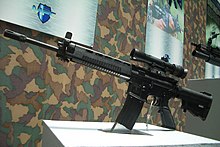
During the Vietnam War , Colt granted numerous licenses to other manufacturers because Colt could not handle this large production volume itself. These licenses were not renewed after the war. The M16 became commercially successful due to the worldwide interest in cheap licensed constructions and further developments. The Belgian FN Herstal also built the M16 in a lighter, semi-automatic version for export . Since 1983, most of the patents for the M16 have expired and any manufacturer can make M16 rifles and their variants. In 1988, FN Manufacturing Inc., based in Columbia, a subsidiary of FN Herstal, was awarded the contract for M16 production by the US Army. NATO countries such as Canada , Denmark and the United Kingdom introduced the assault rifle as a main or supplementary weapon in their armed forces. The weapon is particularly popular in Asia, especially in South Korea , not least because of its relatively low weight. In the Middle East, Israel introduced the M16 and its versions as the successor to the Kalashnikov offshoot Galil .
NATO standards
- The .223 Remington cartridge was developed for the M16 in 1957. A modified version of the .223 Remington, the 5.56 × 45 mm SS109 cartridge , was declared a NATO standard caliber in 1980 (STANAG 4172).
- Thus Assault Rifle Magazine NATO partner for cartridges of caliber 5,56 x 45 mm are interchangeable, as part of a standardization Convention NATO Contracting (were STANAG ) some properties of the M16 magazine (z. B. specific measurements or recess for the magazine holder) for the standardization of magazines (STANAG 4179). Although this convention has never been ratified ( Draft STANAG ), many (but not all) NATO countries have developed or procured assault rifles that can use these standardized magazines ( STANAG magazines ). Some weapons, such as B. the G36 or Galil , these magazines can be used by means of an adapter or by exchanging the magazine slot.
Others
- When the M16 replaced the M14 in the Vietnam War , it was nicknamed Mattel by the US soldiers because of its plastic shaft , after the toy manufacturer of the same name, so it was called: "Do it well, with your Mattel" .
- Another nickname for the M16 is "Sweet Sixteen" ; this also appears in PS-Magazine , a comic-style booklet about gun maintenance that was issued in Vietnam.
- The M16 was also in the earlier years of the Vietnam War "The Black Rifle" ( English for "The Black Gun") called.
Controversy (USA)
After the rampages and attacks in Aurora , Newtown and San Bernardino , which were carried out with AR-15-style self-loading weapons, these and weapons from other manufacturers with similar characteristics moved into public interest. Calls for stricter regulation of the private purchase of weapons, often incorrectly referred to as "assault rifles" in the media, became louder. Particularly after the Orlando incidents , President Obama and other Democratic politicians called for a revision of the nationwide ban on "particularly dangerous" semi-automatic long guns. H. Self-loading rifles , based on features such as pistol grips, muzzle suppressors, ventilation slots on the fore-end, slide-in or folding stocks or interchangeable magazines. Such a ban ( Federal Assault Weapons Ban ) existed until 2004. Proponents of liberal gun laws doubt the effectiveness of such a ban. A 2014 study on this topic could not show any positive effect of a gun ban on the number of illegal killings with firearms.
equipment
The rifles of the M16 model series are equipped with different flash suppressors , cleaning sets, the usual rifle sling and the necessary magazines . There are also a number of optical aiming aids that can be mounted on the handle . Other optical aiming aids can be mounted in place of the carrying handle on certain models (Sniper Model M16A1 Special (655) and the M16A3 / M16A4). As an accessory to the civilian semi-automatic AR-15, a so-called "slide fire stock" ( bump stock ) is available in the United States , which is a legal way of increasing the rate of fire of the weapon. This enables rates of fire that approach those of a fully automatic weapon. The corresponding bayonets also belong to the rifles of the M16 series.
The rifle grenade device (40 mm grenade launcher) M203 is often used with the weapons of the M16 series . One reason for its use is the high susceptibility of the M16 to wear and tear caused by the firing of rifle grenades .
M16A4 with mounted aiming device ( Advanced Combat Optical Gunsight ) and additional assault grip under the fore-end
M16A2 with 40 mm M203 grenade launcher
The M16 can be equipped with a sleeve deflector to prevent irritation to neighboring shooters in the shooting line, during combat operations and during target practice on the shooting range. The case deflector is intended to prevent the long ejection of fired cartridge cases. Fired hot shells could cause burns to the neck / neck area and bare arms of the shooter. Since the case deflectors can also lead to jamming, they are mostly only used on shooting ranges.
literature
- Visor Special No. 37, M 16 & AR-15: the success story of a self-loader - from military rifle to sport rifle. Vogt-Schild Germany, ISBN 3-9809243-5-1 .
- Günter Wollert, Reiner Lidschun, Wilfried Copenhagen : Rifle weapons (1945–1985) . In: Illustrated encyclopedia of rifles from around the world . 3. Edition. tape 2 . Brandenburgisches Verlagshaus, Berlin 1993, ISBN 3-89488-059-7 , p. 464 ff .
- R. Blake Stevens, Edward C. Ezell: The Black Rifle: M16 Retrospective. Collector Grade Publications, Cobourg / Ontario, Canada, 1987, ISBN 0-88935-115-5 .
- Armin Seremek: Two- pronged - experimental weapon based on the AR-15 system. In: Deutsches Waffen-Journal 10/2011, pp. 96–99.
- Headquarters, Department of the Army, TM 9-1005-249-10, Operators Manual for RIFLE, 5.56-MM, M16
- Headquarters, Department of the Army, TM 9-1005-249-24 & P, Technical Manual, RIFLE 5.56-MM, M16 / M16A1.
- Department of the Army and Air Force, ARMY ™ 9-1005-319-23 & P / AIR FORCE TO 11W3-5-5-42, Technical Manual, RIFLE. 5.56MM, M16A2 W / E.
- Gordon L. Rottmann: The M 16. Osprey Publishing, ISBN 978-1-84908-690-5 .
- Patrick Sweeney: The Gun Digest Book of the AR-15 . Gun Digest Books, ISBN 978-0-87349-947-7
Web links
Individual evidence
- ↑ Peter G. Kokalis: Retro AR-15. (PDF). In: nodakspud.com. P. 2 , accessed on May 23, 2020 (English).
- ↑ Ken Elmore: 5.56mm Suppressed Weapons. In: specializedarmament.com. 2003, accessed June 25, 2020 .
- ↑ a b Army Drops Colt as M16 Rifle Maker. In: New York Times. October 3, 1988, accessed October 7, 2015 .
- ↑ The Gun Zone - A 5.56 X 45mm "Timeline" 1980-1985. March 16, 2015, accessed September 17, 2019 .
- ↑ Wayback Machine. December 1, 2012, accessed September 17, 2019 .
- ^ The history of the AR-15, the weapon that had a hand in the United States' worst mass shooting. In: www.washingtonpost.com. Washington Post , June 13, 2016, accessed June 13, 2016 .
- ↑ Assault rifle used in Florida shooting drives US gun control debate. In: The Telegraph. telegraph.co.uk, June 13, 2016, accessed June 13, 2016 .
- ↑ Mark Gius: An examination of the effects of concealed weapons laws and assault weapons bans on state-level murder rates . In: Applied Economics Letters . 21, No. 4, 2014, pp. 265-267. doi : 10.1080 / 13504851.2013.854294 .
- ↑ Joseph von Benedikt: Shoot your AR-15 faster than ever with a Slide Fire Stock. In: Shooting Times. July 22, 2011, accessed October 7, 2015 .





